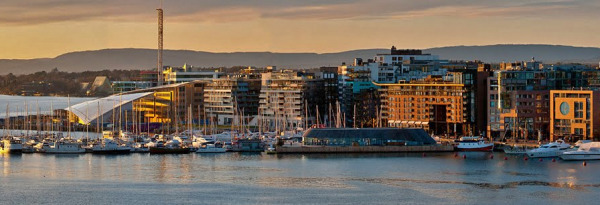 The Norwegian capital has the dubious distinction, three years running, to be THE most expensive city in the world, beating London, Tokyo and Paris. No matter how much you hear about how costly it is, you can't avoid the breathtaking shock of a $30 five minute taxi ride, the same $30 for a shot of aquavit and a small beer, or the $28 price for a tiny bottle of scotch in the hotel mini-bar. Still, it's a beautiful city, very water-oriented like San Francisco, Hong Kong or Vancouver, with a lot of character and full of very friendly people. If you're sucking it up and going, here are a few highlights from just over a day-and-a-half at the summer solstice.
The Norwegian capital has the dubious distinction, three years running, to be THE most expensive city in the world, beating London, Tokyo and Paris. No matter how much you hear about how costly it is, you can't avoid the breathtaking shock of a $30 five minute taxi ride, the same $30 for a shot of aquavit and a small beer, or the $28 price for a tiny bottle of scotch in the hotel mini-bar. Still, it's a beautiful city, very water-oriented like San Francisco, Hong Kong or Vancouver, with a lot of character and full of very friendly people. If you're sucking it up and going, here are a few highlights from just over a day-and-a-half at the summer solstice.
This 40 hours counts 10 hours of sleep for two nights, since my very late Norwegian Air flight finally got me to the new design hotel The Thief in the trendy harborside area of Tjuvholmen at 3:30 am, and I didn't start my rounds til about 10 am. There is lots to see in this short window, and a couple of ways to mitigate large getting-around expenditures are the Oslo Pass, which provides access to most museums and sights, as well as all public transportation, and a transport pass, which covers just the latter for around $20 for 24 hours. The combination of ferries, subways, trams and busses makes it easy to get around the city.
Vigeland Sculpture Park 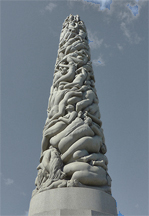 From the harbor the number 12 tram takes about 6 minutes to reach the gates of the 80-acre Vigeland Sculpture Park, set within Oslo’s Frogner Park. This large greensward commences at the main gate of granite and wrought iron, and includes a long axis of hundreds of greater-than-life size sculptures by one of Norway’s best-known artists, Gustav Vigeland. These are bronze and granite groups of men, women and children--all nude--in an endless combination and variety of poses depicting joy, anger, angst, aggression, love and sex. An enormous fountain of Atlas-like men holding a huge basin fills the center pavilion. At the northern end of the axis sits the Monolith, a sky-pointing granite finger covered with inward facing bodies of people crawling in, around and over each other struggling for the peak—seemingly an analogy of the human stretch for understanding.
From the harbor the number 12 tram takes about 6 minutes to reach the gates of the 80-acre Vigeland Sculpture Park, set within Oslo’s Frogner Park. This large greensward commences at the main gate of granite and wrought iron, and includes a long axis of hundreds of greater-than-life size sculptures by one of Norway’s best-known artists, Gustav Vigeland. These are bronze and granite groups of men, women and children--all nude--in an endless combination and variety of poses depicting joy, anger, angst, aggression, love and sex. An enormous fountain of Atlas-like men holding a huge basin fills the center pavilion. At the northern end of the axis sits the Monolith, a sky-pointing granite finger covered with inward facing bodies of people crawling in, around and over each other struggling for the peak—seemingly an analogy of the human stretch for understanding.
The outdoor cafe attached to the Oslo City Museum at the edge of the park was right-place, right time for a lunch break, coinciding with a break in the 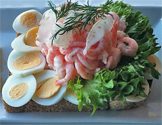 rain, and offers a lovely view of the lake and park. Smorebrod is the Norwegian national specialty of open-faced sandwiches. A perfect form here is the Skagenrøre, or shrimp skagen--ultra-fresh shrimp salad atop an oval of rye bread, crowned with a bit of creme fraiche and orange roe. That and a glass of lager makes a perfect lunch at only 175 kroner, or around $32.
rain, and offers a lovely view of the lake and park. Smorebrod is the Norwegian national specialty of open-faced sandwiches. A perfect form here is the Skagenrøre, or shrimp skagen--ultra-fresh shrimp salad atop an oval of rye bread, crowned with a bit of creme fraiche and orange roe. That and a glass of lager makes a perfect lunch at only 175 kroner, or around $32.
Munch at 150 years
Edvard Munch is arguably Norway's most famous son--well, perhaps shared with Alfred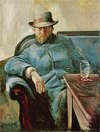 Nobel? Oslo is commemorating the 150th anniversary of his birth, which the city and the National and Munch Museums are jointly celebrating with a retrospective of his work assembled from museums and collections the world over. Early works, from the late 1800's through 1904, and which include a version of the iconic "Scream" are at the National, and the later works at the Munch. I knew little of his work save the Scream, and admit that I've missed a lot. His early work included realistic portraits and impressionst scenes that are quite delightful.
Nobel? Oslo is commemorating the 150th anniversary of his birth, which the city and the National and Munch Museums are jointly celebrating with a retrospective of his work assembled from museums and collections the world over. Early works, from the late 1800's through 1904, and which include a version of the iconic "Scream" are at the National, and the later works at the Munch. I knew little of his work save the Scream, and admit that I've missed a lot. His early work included realistic portraits and impressionst scenes that are quite delightful.
Central Oslo Stroll
A walk from the Royal Palace to the Parliament buildings—Stortinget takes in the National theatre, Ibsen's gate, the tree-lined fountained park and open-air meeting place along Karl Johan's Gate. The blocks past the Stortinget are the major shopping streets of Oslo containing the usual urban center suspects found worldwide, as well as some uniquely Oslo shops.
Craft brewing has become a big thing in Oslo. Several renowned brewpubs offer a huge variety of draft beers. Amundsen Bryggeri & Spiseri, a brewpub and restaurant is one such, and provides a needed load off after hours of walking. There I encounter the aforementioned third-liter of lager and a shot of sherry cask-aged Gammel aquavit in a snifter—exuding aromas of caraway, nutmeg and vanilla: 180 kroner, or around thirty bucks.
Tjuvholmen
Tjuvholmen, which means Thief Island, is a newly reclaimed part of industrial docklands that contains cutting-edge architecture housing offices, residences, restaurants, galleries, shops and hotels, and the stunning majestic glass, steel and timber (isn't it good, Norwegian wood) structure by Renzo Piano -- the swoop of the roof sort of like an enormous eagle with wings on the downstroke-- housing the the Astrup Fearnley Museet. I must admit to liking the architecture much more than the current jarring exhibit by Cindy Sherman, who's photography seems obsessed with the bizarre and genitalia, and the tank-encased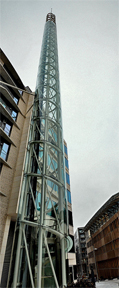 split cows of Damian Hirst. There is an adjacent small sculpture park dotted with several pieces by Louise Bourgeois, Anish Kapoor and others, that will no doubt be extended with time. But the strutucture itself is not to be missed.
split cows of Damian Hirst. There is an adjacent small sculpture park dotted with several pieces by Louise Bourgeois, Anish Kapoor and others, that will no doubt be extended with time. But the strutucture itself is not to be missed.
Sneak Peek—the Tjuvtitten
Near the museum is a 90 meter tall Chinese finger-puzzle of steel and lexan in which a single cylindrical elevator rises slowly above Thief Island to provide a stunning 365 degree view of the Oslo skyline, and the island and peninsula dotted harbor where ferries, sailboats and two antique schooners plying the tourist trade cut silver wakes across the water. At 20 kroner, or around three dollars, this could well be the best deal in town.
Hanami
A packed and very popular restaurant called Hanami, just across the canal from the hotel, styles itself as modern Japanese cuisine—a combination of sushi, robatayaki and Izakaya style dining. The place is packed, and luckily I had reserved a spot at the sushi bar, which gives a vista of not only the knife-wielding sushi chefs, but the robata grill. The place is jumping with beautiful people--mostly blond, as would be  expected. A 20ish blond Rolex-wearing Swede relocated to Norway called Phillip sits next to me, and orders only foie gras sushi, about which he rhapsodizes. He seems to be known to all the waitstaff, and soon has a shot of clear, glass of wine and a beer lined up in front of him. Dinner is delicious: Sushi chef June comps young Phillip a tuna tataki, and graciously includes one for me. Thereafter, four pieces of nigiri sushi, four spears of grilled asparagus with grapefruit hollandaise, and three tempura prawns with two glasses of Bandol rose set the kitty back a mere $165.
expected. A 20ish blond Rolex-wearing Swede relocated to Norway called Phillip sits next to me, and orders only foie gras sushi, about which he rhapsodizes. He seems to be known to all the waitstaff, and soon has a shot of clear, glass of wine and a beer lined up in front of him. Dinner is delicious: Sushi chef June comps young Phillip a tuna tataki, and graciously includes one for me. Thereafter, four pieces of nigiri sushi, four spears of grilled asparagus with grapefruit hollandaise, and three tempura prawns with two glasses of Bandol rose set the kitty back a mere $165.
Oslo Harbor & Museums
The transport pass includes ferries, and the next morning I board the 9:15 for Bygdøy and the museums there. The leaden sky turns to light rain as the ferry pulls out. Regardless of destination, this ride is worth the pass for the immersive experience of the 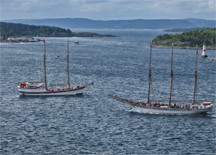 waterways, islands and coves of the harbor. First stop is for the Norsk Folk Museum, and Viking Ship Museum. The nfm is essentially a park with reconstructions of 100+ year old villages from all over Norway: tiny dwellings with a central hearth, cowsheds, grain stores and barns of log and plank construction, most with sod roofs--living roofs are not new. It's an interesting view into a past lifestyle of toughness and grit.
waterways, islands and coves of the harbor. First stop is for the Norsk Folk Museum, and Viking Ship Museum. The nfm is essentially a park with reconstructions of 100+ year old villages from all over Norway: tiny dwellings with a central hearth, cowsheds, grain stores and barns of log and plank construction, most with sod roofs--living roofs are not new. It's an interesting view into a past lifestyle of toughness and grit.
The Viking Ship Museum contains several wooden Viking rowing ships, the most striking one of which is the competely intact Oseberg ship, which dates to the ninth century or earlier.
Fram and Gjoa
The second ferry stop provides access to the Maritime Museum, and the 19 th century wood hulled icebreaker FRAM. the entire ship is contained in the A frame building, with galleries around to view its decks, and access directly onto the main deck. Historic photos, artifacts and models are displayed in the walls surrounding the ship, and the courage and intrepidity of these early explorers is palpable. A later and smaller exploration vessel, Gjoa, was unveiled just three weeks ago in an adjacent A frame.
Botaniske Hage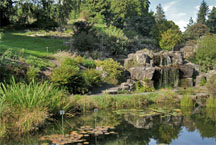 Hage is the Norsk word for garden, rather than referring to an old crone. The number 12 tram, with transfer at Jernbanetorget to the T Bahn or underground brings one to Toyengate and the green oasis of the botanical garden associated with the University since 1814. Much of the garden is devoted to the arboretum and trees, but the terraced rock garden with churning stream and waterfall, underwritten in the 70's by a San Francisco physician, is a gem. Gramma's Garden is a collection of mature and scented perennials, almost all blooming, and the Systematic Garden is a very interesting concept: a teaching display of taxonomy, grouping plants by families to, show their similarities and differences.
Hage is the Norsk word for garden, rather than referring to an old crone. The number 12 tram, with transfer at Jernbanetorget to the T Bahn or underground brings one to Toyengate and the green oasis of the botanical garden associated with the University since 1814. Much of the garden is devoted to the arboretum and trees, but the terraced rock garden with churning stream and waterfall, underwritten in the 70's by a San Francisco physician, is a gem. Gramma's Garden is a collection of mature and scented perennials, almost all blooming, and the Systematic Garden is a very interesting concept: a teaching display of taxonomy, grouping plants by families to, show their similarities and differences.
A small lunch to finish—and the Bill totalled
An hour’s walk brings me back to Tjuvholmen. Berghaven Bakerai & Konditerii sits between the museum and the hotel, at which I need to pay the enormous bill and depart for the airport in an hour. Shrimp skagen started this forty hours, and shrimp and crayfish skagen on wonderful multigrain bread, washed down with a Haandbryggeriet pale ale from the south of Norway end it. This 160 kroner lunch, together with the hotel bill, and the $150 taxi to the airport shared with two Dutch ladies checking out at the same time, bring the grand total for forty hours to $1,485, or just under forty bucks per hour, asleep or awake.